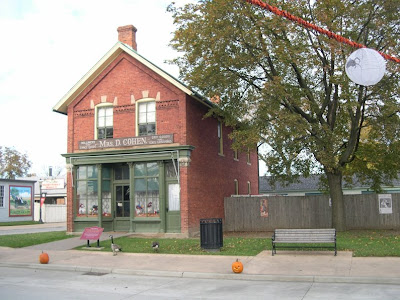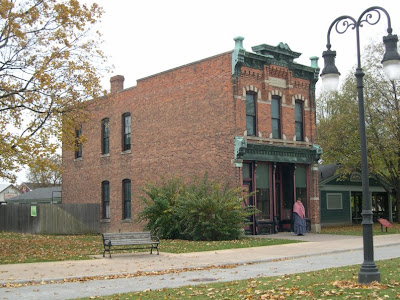Cohen Millinery Shop (previously known as Mrs. D. Cohen's Millinery Shop, Magill Jewelry Store, and Baker Street Jewelry Store)
 With the classic architecture of the mid-to-late 19th century, this building has been though a number of businesses before Mr. Ford became its owner. Originally I wrote of this structure as being a mistake that Henry Ford had made when he purchased and relocated it inside of Greenfield Village in 1935. He claimed it once housed the jewelry store run by Mr. Magill in the 1870's and early 1880's at which he himself worked part time repairing clocks and watches.
With the classic architecture of the mid-to-late 19th century, this building has been though a number of businesses before Mr. Ford became its owner. Originally I wrote of this structure as being a mistake that Henry Ford had made when he purchased and relocated it inside of Greenfield Village in 1935. He claimed it once housed the jewelry store run by Mr. Magill in the 1870's and early 1880's at which he himself worked part time repairing clocks and watches.But as I researched this shop I had heard that during the 1990's the Village historians felt Henry Ford actually bought the building from which a Mrs. Cohen conducted her Millinery business and not the Magill building as he assumed.
And word got out that Ford made another historical blunder (see Susquehanna Plantation and the Stephen Foster Memorial).
That's when I decided to investigate this 'mistake.' I mean, Ford worked at the building - wouldn't he had known what it looked like?
What I found showed a wonderful piece of history that has added a new light and life to this old building in my eyes.
According to the book 'Young Henry Ford' by Sidney Olson (c1963):
"(In 1879/1880) Henry went to the jewelry shop of his friend Robert Magill where (he) had often bought watch parts. He got a job at 50 cents per night, $3 per week for six nights of six hours each.
Henry was slight and looked even younger than his sixteen years. In order not to scare away trade, as customers would only trust their time-pieces with bearded veterans. Magill had Henry slip in the side door, to work out of sight in a little back room.
 |
| Note the side door where young Henry Ford would slip in unnoticed to work on customer's watches and clocks |
By March, 1882, Henry was living in a Mrs. Simms' boarding house on Jefferson Avenue. He no longer worked on watches for Magill, who had moved across Baker Street to work alone in his own home, after selling his shop to a milliner, a Mrs. Cohen."
I believe that this answers the question on Mr. Ford's 'mistake.' It wasn't a mistake at all; just showing this building after Magill had sold it. And since there was already another jewelry store inside Greenfield Village, management felt - and rightly so - they should show another building and occupation of the time.
I am sorry, however, that I have no photographs of this building as Magill's Jewelry Shop.
 This millinery shop, located at 444 Baker Street in Detroit, represents the new wave of specialized stores in the larger cities in the late 19th century. It was here that Mrs. Elizabeth Cohen made her living decorating women's hats from 1892 to 1903, catering to mainly the middle class genre.
This millinery shop, located at 444 Baker Street in Detroit, represents the new wave of specialized stores in the larger cities in the late 19th century. It was here that Mrs. Elizabeth Cohen made her living decorating women's hats from 1892 to 1903, catering to mainly the middle class genre. Mrs. Cohen purchased ready-made hat bodies from manufacturers, then trimmed them to the tastes of her customers with ribbons, artificial flowers, feathers, and buttons. She also sold various fabrics, notions, and gentlemen's accessories such as ties, cuff links, and shirt collars.
Mrs. Cohen purchased ready-made hat bodies from manufacturers, then trimmed them to the tastes of her customers with ribbons, artificial flowers, feathers, and buttons. She also sold various fabrics, notions, and gentlemen's accessories such as ties, cuff links, and shirt collars. As the shop now sits in Greenfield Village, presenters dressed in period clothing continue to trim hats in this building.
As the shop now sits in Greenfield Village, presenters dressed in period clothing continue to trim hats in this building. Records show that the building was originally built around 1879/1880 in Detroit.
Records show that the building was originally built around 1879/1880 in Detroit..



Comments